RAG, short for Retrieval-Augmented Generation, may not be a novel term these days. This technique is considered a breakthrough in making large language models (LLMs) catch up with what’s happening in the world. Without RAG, your LLM-based application may offer outdated, irrelevant, or even hallucinated responses to users. This is very harmful in areas where information accuracy and relevance are paramount, typically medical diagnosis, legal advisory services, or customer support. To simplify the integration of RAG into LLMs, various open-source RAG frameworks are introduced, with some giants like LangChain or LlamaIndex. So, what are these tools exactly? Which frameworks are leading the race, and how can you choose the best fit for your business? The article will figure it out!
What is the Open-Source RAG Framework?

Open-source RAG frameworks are software programs released under an open-source license to build a RAG pipeline. These frameworks often provide pre-built building blocks or components that anyone can use, adjust, or even contribute to freely. Accordingly, these components are designed to simplify RAG system development end-to-end, from data ingestion to response generation.
- Document Ingestion & Preprocessing: Some RAG frameworks offer tools to access and break down long documents. In LangChain, for example, what takes care of this job is document loaders and text splitters.
- Embedding: Machines don’t understand our natural language inputs (including documents and queries). So we need to convert our text chunks into numerical vectors (“vector representations” or “embeddings”) so that the machines can read and interpret. LangChain, for example, often engages embedding models in this task.
- Vector Database Integration: This often involves vector stores/databases to store and search for the embeddings later.
- Retrieval: When a user sends a query, retrievers perform search methods, like DPR (“Dense Passage Retrieval” for semantic searches), BM25 (the traditional keyword search), or a hybrid search to extract the most relevant information. For example, in LangChain, retrieval systems compare the numerical vectors of both the stored data and the query to find the closest values in a high-dimensional vector space. This identifies which information is most relevant to the given query.
- LLM Integration: Retrieval systems then fuse the original question and the retrieved information into a prompt to guide how the chat models (“LLMs”) should respond.
Apart from these must-have components, open-source RAG frameworks may integrate other components to enhance the RAG system. They may include prompt templates, productivity toolkits, databases, etc. Further, several frameworks can incorporate testing and evaluation tools to measure how RAG systems perform.
What is the Main Purpose of RAG Frameworks?
The primary goal of RAG frameworks is to make RAG system development simpler and more efficient through their ready-to-use structure and built-in components. Without a framework, developers must spend much time and effort on writing custom scripts for document ingestion, retrieval, ranking, prompt engineering, and integration with LLMs. This is often time-consuming, prone to errors, and hard to maintain at scale. But by using RAG frameworks, developers only need to focus on business logic and let the frameworks handle these development complexities. This makes the entire RAG pipeline faster, more reliable, and easier to scale.
What Kinds of Data Can RAG Frameworks Use?
RAG frameworks can process any type of data, including unstructured text data, semi-structured data, structured data, and even multimodal data. However, taking a glance over open-source RAG frameworks, we see that they still primarily focus on handling unstructured text data over others. Here’s how:

1. Unstructured text data
This data type refers to text that doesn’t follow a specific structure or format. Its common sources often include policy manuals, web pages, social media posts, research articles, or any documents that don’t organize data in rows and columns like relational databases. Although it still contains numbers and dates, unstructured data is still predominantly text. This data is so valuable that it can help your business deeply understand market trends, perform sentiment analysis, support onboarding, and more.
To exploit unstructured text data, open-source RAG frameworks, like LangChain, often use document loaders. These tools assist with ingesting the data from various sources, cleaning & normalizing it, and transforming it into a format that the frameworks can work with (often plain text plus metadata).
2. Semi-structured data
Semi-structured data is a mixture of unstructured and structured data. It doesn’t conform to a predefined structure like a database, but also includes some tags and metadata. For example, HTML files are considered semi-structured as they contain structured elements (e.g., “headings,” “paragraphs,” or “links”) but the content inside is unstructured.
Open-source RAG frameworks often process this data with loaders or parsers. For example, LlamaIndex uses “data loaders” or “connectors” like `NotionPageReader` to load semi-structured data from JSON files, Notion pages, etc.
3. Structured data
Structured data is typically information organized in a pre-defined schema for easy searching and retrieval. For example, customer information, including names, addresses, and phone numbers, is considered “structured data.”
Open-source RAG frameworks ingest and pre-process this data in different ways. For instance, Haystack often depends on database connectors (e.g., SQLDocumentStore or pipelines that query databases directly) to transform structured data into Haystack `Document` objects. Meanwhile, LangChain integrates with relational databases via text-to-SQL and supports graph databases through connectors like Neo4j.
4. Multimodal data
Multimodal data includes other types of information beyond text, like images, audio, and videos. Most open-source RAG frameworks now ingest and pre-process this data indirectly by transforming it into text. For example, some research used video captioning tools to generate text transcripts from videos.
Frameworks like LangChain enable chat models to perform such pre-processing by calling external tools (e.g., BLIP for image captioning or Whisper for audio-to-text). The reason is that most embedding models and vector stores are mainly text-based, and multimodal support is still limited. However, some embedding models like CLIP or ImageBind on Hugging Face still support multimodal embeddings, although they’re not yet widely adopted in RAG frameworks.
Top 7 Open-Source RAG Frameworks for Enterprise Solutions
The market for RAG frameworks is becoming more dynamic than ever before, with an estimated $1.85 billion in 2025. Some research predicted that the market will grow at lightning speed in the upcoming years, as an inevitable result of the increasing demand for real-time, accurate data and machine learning advancements. So, which open-source RAG frameworks are leading the market? Let’s dive into the 7 best tools with Designveloper!
Haystack
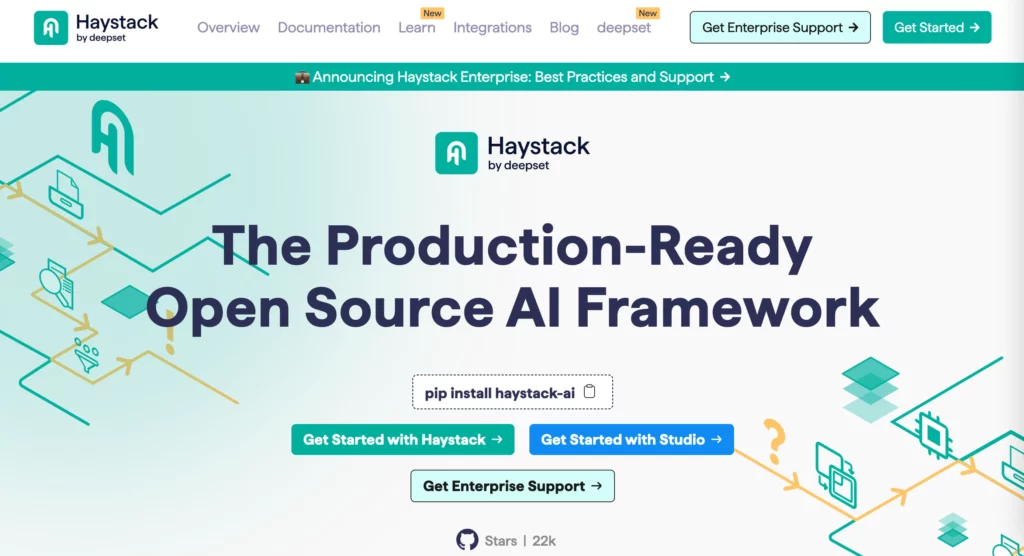
Haystack is an open-source framework developed by Deepset to help developers build powerful and production-ready LLM applications. Its modular architecture allows you to connect the best technologies from OpenAI, Chroma, Hugging Face, etc, to develop around your specific use cases and specifications. Whether you want to build simple RAG apps, complicated agentic pipelines, multi-modal systems, or autonomous agents, Haystack offers the right tools to turn your idea into working solutions easily.
Haystack is for builders of all kinds, as long as you know a bit of Python. The framework also offers easy setup and a strong developer community to support you in need. Besides, it comes with the following elements:
- Modular Design with Diverse Components, Pipelines, & Data Classes:
- Haystack provides a wide range of pre-built components to perform different kinds of tasks. Some of them include generators (for creating text responses), retrievers (for finding the most relevant info), and embedders (for converting texts into numerical vectors). You can use these components stand-alone (outside a pipeline) or in a pipeline, or create your own.
- Combining all of these components, you can build flexible pipelines for your project by adding loops or branches. The entire pipeline setup (including configurations) can be serialized (saved and reloaded), making it easy to run on Kubernetes (K8s). Besides, you can leverage `SuperComponent` to wrap a complete pipeline into a single component for later reuse.
- Haystack comes with different data classes (e.g., Answer or ByteStream) to help components interact with each other efficiently.
- Hayhooks: a web application that helps you deploy and serve Haystack pipelines as REST APIs or as an MCP Server.
- Built-in Tracing, Logging, and Evaluation Tools: Assess individual components or entire pipelines in different scenarios.
LangChain
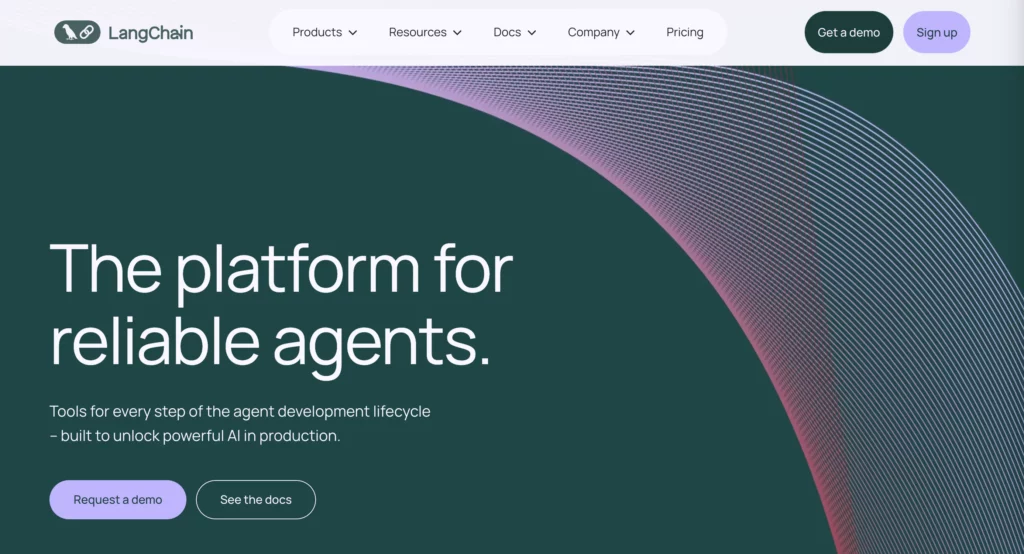
LangChain is an open-source, composable platform you can leverage to build reliable agents powered by LLMs and RAG. It offers a visual agent IDE, pre-built templates, and multiple tools to assist with technical complexities. Whether you want to build native co-pilots, research assistants, code generators, or any smart bots, the framework provides a standard interface to accelerate your development. Here are several reasons why you should consider LangChain:
- Modular Design:
- LangChain offers open-source components and third-party integrations from trusted providers like OpenAI, Azure, Google, or AWS to support your RAG app development. These components include chat models, retrievers, document loaders, vector stores, embedding models, and other useful toolkits. These components connect LLMs to real-time data sources, APIs, and internal systems, ensuring that the data will flow seamlessly through an RAG pipeline.
- Chains are also fundamental components for developing LLM applications in LangChain. They’re a sequence of reusable components linked together; they can remember things, be monitored at runtime using Callbacks, and be combined with other chains or components.
- Prompt Engineering and Management: LangChain provides reusable prompt templates and utilities for prompt construction. Instead of creating a brand-new prompt every time, you can build a structure with placeholders (“blanks”) filled with dynamic inputs.
- Integration with Lang-family products: LangChain integrates seamlessly with LangSmith, LangGraph, and LangGraph Platform. LangGraph Platform helps deploy your agents at scale, while LangGraph is used for orchestrating complex AI agents controllably. Besides, you can use LangSmith to debug and evaluate your applications with granular visibility and monitoring.
LlamaIndex
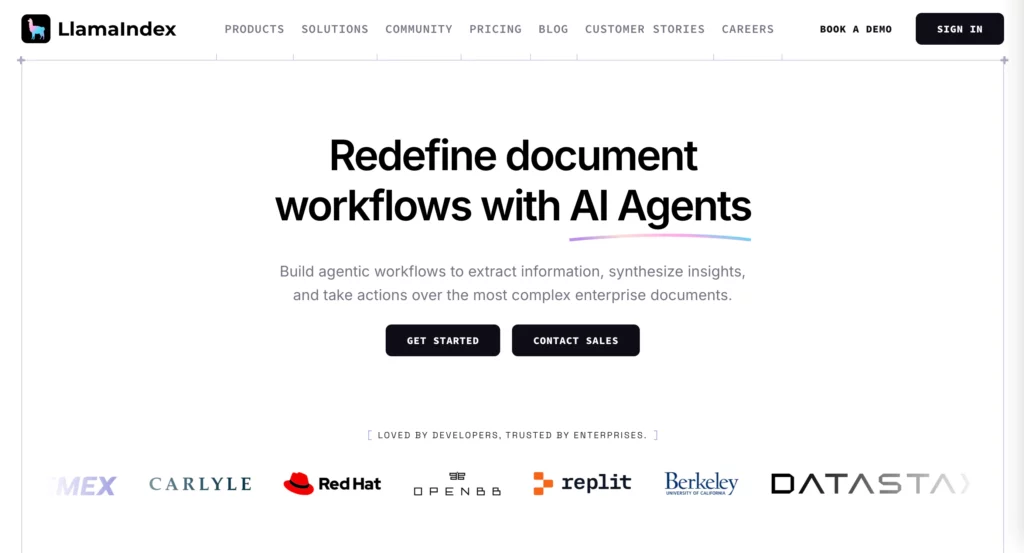
LlamaIndex is a flexible framework available in Python and TypeScript. It simplifies the ingestion, indexing, and querying of enterprise data for LLM-powered applications. The framework is widely adopted to build knowledge assistants and agentic workflows that seamlessly connect your enterprise data, derive insights, and even take actions.
LlamaIndex offers modular components, including embedding, prompting, loading, indexing, storing, querying, and LLMs integration. All these components mainly work with textual data. However, there’s emerging support for multi-modal RAGs through LlamaExtract. This specialized tool is offered through LlamaCloud to effortlessly retrieve structured data from unstructured documents (e.g., PDFs, claims, or contracts) with high accuracy. It supports advanced capabilities, like schema-driven extraction, reasoning, or citations.
Besides these fundamentals, LlamaIndex offers advanced features to build AI agents with conversational memory or deploy multi-step workflows. The framework also delivers evaluation and observability tools to test, debug, and improve your applications.
LlamaCloud is an enterprise-grade hosting platform that standardizes the development of your knowledge assistants with quick setup time. Its intuitive interface enables you to parse documents (LlamaParse), extract structured data (LlamaExtract), and monitor agentic RAG workflows with enterprise-grade scalability and security.
RAGFlow

RAGFlow is an open-source RAG engine that focuses on deep document understanding across diverse and complex formats. This empowers LLMs to generate citation-backed, grounded responses.
The engine supports LLM integration via APIs and also enables local model deployment using frameworks like Ollama or Xinference. This gives you flexibility around performance, cost, and privacy.
RAGFlow helps you create knowledge bases easily by uploading different document formats, selecting chunking methods, choosing embedding models, and parsing files into indexed knowledge. It also supports metadata control (keywords, page ranking), retrieval testing, knowledge graph construction, auto-keyword/auto-question features, RAPTOR, and more to optimize retrieval.
RAGFlow allows you to create AI chat assistants that work based on your knowledge bases. Through its visual node editor, you can also develop AI agents with multi-step reasoning, memory, and tool use. Further, the engine allows for detailed observability by integrating Langfuse to inspect and debug every retrieval and generation step.
txtAI
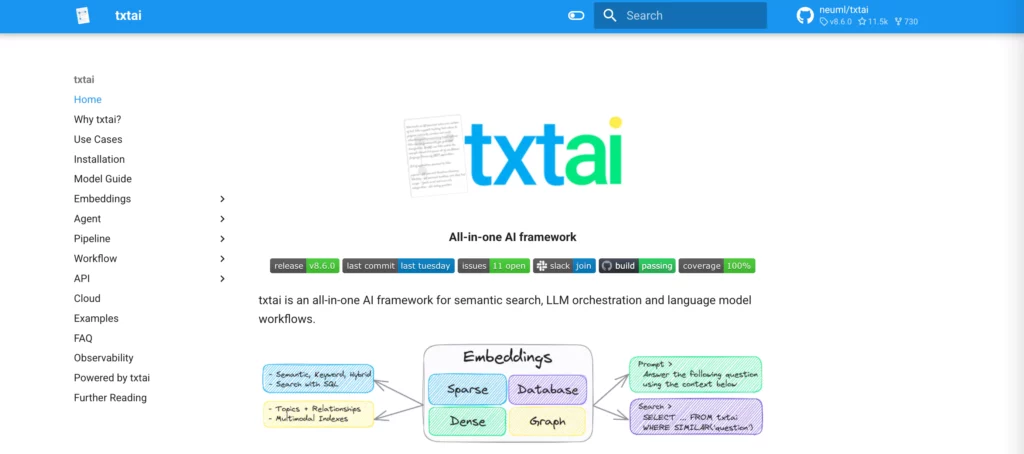
txtAI is a comprehensive AI framework that streamlines semantic search, LLM orchestration, and language model workflows. As an open-source platform under Apache 2.0 licensing, it features an embeddings database, which integrates sparse/dense vector indexes, graph networks, and optional relational structures. This capability allows for powerful vector search capabilities, making txtAI a good option to build RAG pipelines, autonomous agents, multi-model workflows, and more. Importantly, the open-source framework enables multi-modal embeddings – including textual data, audio, images, and videos.
Beyond this core component, txtAI can:
- Assist with creating LLM-powered pipelines that run prompts, answer questions, perform translations, summarize, and more.
- Combine pipelines into logic-rich workflows, whether simplex microservices or complex multi-model orchestration.
- Build agents that connect different components – such as embeddings, workflows, pipelines, and other agents – to autonomously address complex issues.
- Feature Web and MCP (Model Protocol) APIs, with languages bound in JavaScript, Java, Go, and Rust.
- Enable local deployment and scalability using container orchestration architectures.
Cognita
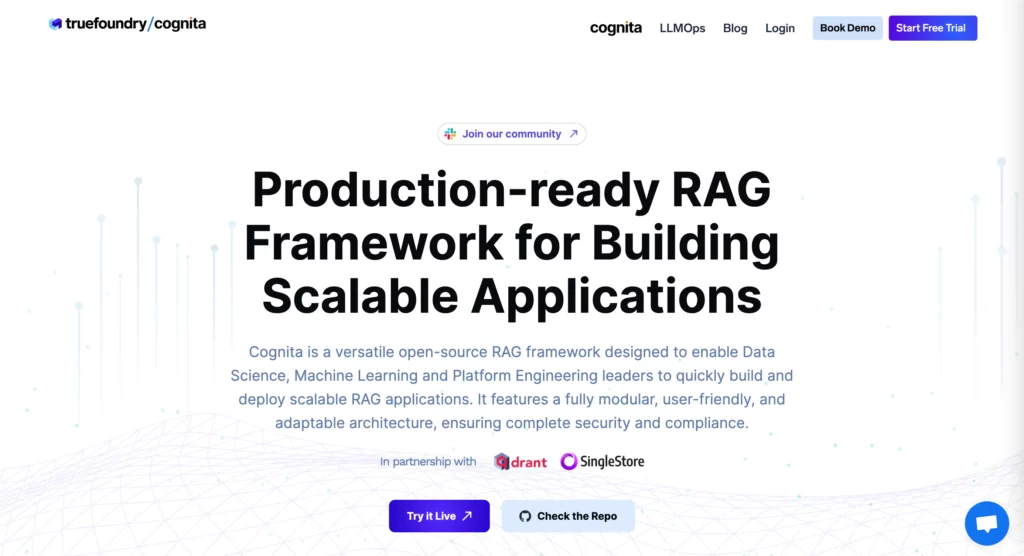
Cognita is an open-source, production-ready RAG framework developed by Truefoundry. The framework aims to support data scientists, machine learning specialists, and platform engineers in creating and deploying scalable RAG systems quickly. Its modular architecture allows you to integrate with multiple reusable components and systems effortlessly while ensuring complete compliance and security:
- Parsers: Can work with different data types (e.g., regular text files, Markdown files, or PDFs).
- Data Loaders: Ingest data from different sources (e.g., local directories, Truefoundry artifacts, or databases).
- Embedders: Support numerous pre-trained models from OpenAI, Cohere, and other trusted providers in embedding data.
- Rerankers: Support SOTA, one of the most advanced rerankers available, developed by mixedbread-ai, as of April 2024.
- Vector DBs: Support different vector stores available, like Chroma, Quadrant, Singlestore, or Weaviate.
- Query Controllers: Process multiple requests concurrently and auto-scale resources when needed, especially during traffic spikes.
Dify
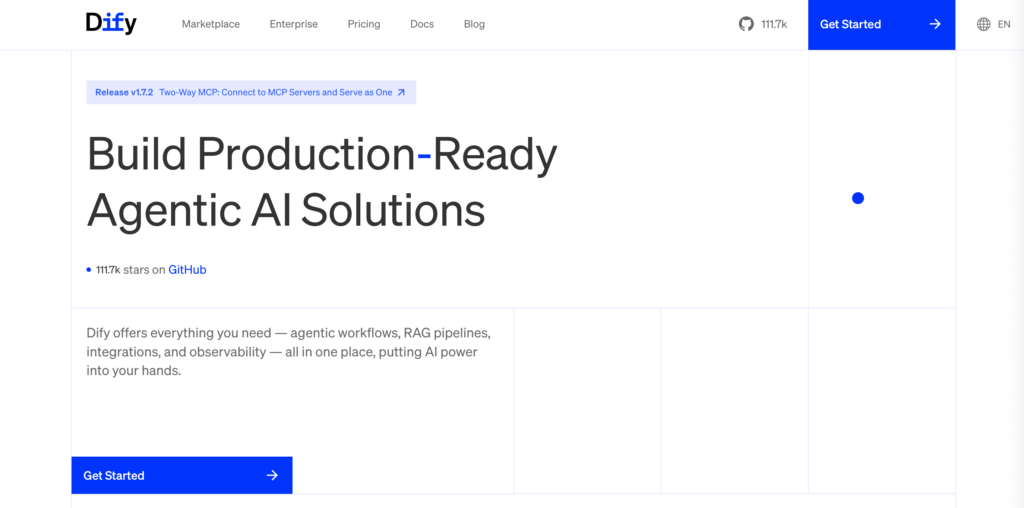
Dify is the last open-source RAG framework we want to introduce in this list. It offers everything you need to build production-ready AI solutions. You can leverage its drag-and-drop interface to develop agentic workflows that are capable of handling different tasks and changing needs. Dify’s Backend-as-a-Service handles all the development complexities, allowing you to turn Dify-built workflows into a standard MCP server accessible to any MCP clients.
You can supercharge your AI solutions with global LLMs, RAG pipelines, tools, agent strategies, and more. Accordingly, it allows seamless integrations with various open-source and closed LLMs, like OpenAI’s models, Hugging Face’s models, Grok, DeepSeek, and more. These integrations are done effortlessly through standardized MCP protocols. Further, you can extend your AI app’s capabilities with powerful plugins, like Slack, QRCode, xAI, AWS, and more.
Dify also enhances your AI systems with multimodal capabilities, smart strategies, extensions, and bundles. It allows you to extend their capabilities and automate tasks by installing your favorite tools.
Comparative Insights for Selecting the Best RAG Framework
So, among open-source RAG frameworks, which one should you choose? Beyond technical features, you should consider other crucial factors, like licensing, integration, and ease of use.

Licensing & Open-Source Availability
When choosing a RAG framework, you should check its license first. This factor determines whether you can use the framework for commercial purposes without worrying about legal risks.
Apache-2.0 and MIT are two permissive licenses considered friendly to businesses. They allow you to adjust and redistribute the code, as well as keep your modifications private. The frameworks in our list use these licenses.
If you choose other frameworks outside our list, be careful with their licensing. Those leveraging copyleft licenses, like AGPL/GOL (restrictive licenses), force you to open-source your entire project if you make changes and redistribute your proprietary code. This puts your business in privacy risks.
Level of Modularity and Ecosystem Integration
Choose a framework with a rich ecosystem and modular architecture if you plan to scale or experiment with various backends.
This framework allows you to plug and swap out its built-in components, including embedding models, retrievers, vector databases, or LLMs, without writing them from scratch. For example, LangChain has chains and agents to connect hundreds of integrations together, while Haystack’s pipeline abstraction offers interchangeable nodes (readers, retrievers, etc.).
Such a modular design and diverse integrations help you decide on which components work best for your project.
Ease of Use: Code vs UI-Based Workflows
Who in your company are the main users of open-source RAG frameworks? The answer matters as some frameworks are developer-first and others provide UI-based or low-code workflows. If your team includes data scientists and engineers, code-based frameworks like LangChain or LlamaIndex are fine. Otherwise, prioritize frameworks with UI tools to democratize usage for non-developers or quick prototyping.
Context Window & Support for Large Documents
Chunking is an important step in an RAG pipeline, as too long or short chunks can impact how your RAG system retrieves useful, relevant information. If your main use case involves long PDFs, complex contracts, or research papers, choose frameworks with advanced indexing and chunking strategies to avoid context loss.
Ideal Applications for RAG Frameworks
Different frameworks have different strengths. So you should align framework choice with your project scale, team expertise, and deployment environment. For example, if you want to build an enterprise Q&A assistant, choose frameworks with some criteria such as reliability, integrations with enterprise systems, and the ability to handle concurrent requests. Haystack and LangChain (with LangSmith) are two good options for this case because they’re developed for production use.
Conclusion
RAG frameworks, especially open-source ones like LangChain or Haystack, are gaining traction. They offer a wide range of built-in components and third-party integrations to streamline the development of RAG pipelines, whether simple or complex. These frameworks can load and pre-process many types of data, but mostly focus on unstructured text formats.
Among multiple open-source RAG frameworks, you should consider your specific requirements first, and then consider important factors like ease of use, modularity level, available integrations, etc. These criteria help you pick the most fitting tool for your project. Nothing can be perfect at first choice. Therefore, experiment with different RAG frameworks and possibly combine some best ones to achieve the desired results.
In case you want to find expert help, Designveloper is a trusted, experienced partner. We’re a leading software development company in Vietnam, with 12 years of experience in turning innovative ideas into working solutions. Our expertise spans across 50+ modern technologies and different industries, helping us implement 200+ successful projects.
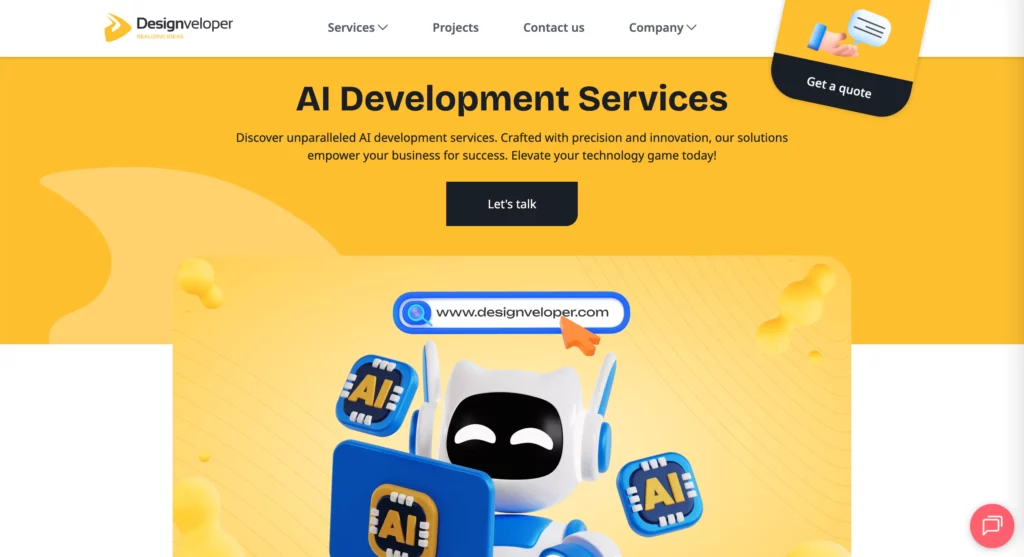
At Designveloper, our skilled developers and AI specialists excel at delivering LLM-powered applications using RAG frameworks, typically LangChain. These products seamlessly integrate OpenAI’s models, vector databases, and enterprise knowledge sources to generate precise, context-aware responses. We also incorporate advanced features, such as memory for multi-turn conversations, API connectivity for real-time data retrieval, and multi-tool integration. Whether you need an AI chatbot or enterprise-grade automation software, Designveloper has the right expertise and tools to deliver. Contact us now and discuss your idea further!
Bonus: Can RAG Frameworks Work With OpenAI or Hugging Face Models?
The answer is yes. Open-source RAG frameworks are designed to work seamlessly with OpenAI and Hugging Face models. Frameworks like LangChain or Haystack offer built-in integrations with OpenAI’s models. They provide prompt templates to guide these language models on how to respond, fuse the retrieved information and the original query into the prompt, and send it back to the models for generating effective answers.
Unlike OpenAI’s closed models, Hugging Face provides a wide range of open-source language models (e.g., BERT, LlaMA-2, T5, or Falcon). These models can be incorporated into open-source RAG frameworks directly through the Hugging Face Inference API or locally via the Transformers library. With the API, you don’t need to download or set up the models locally. Instead, RAG frameworks provide connectors to this API, allowing you to call the models to answer questions. Otherwise, the Transformer library enables you to download and run the language models on your own environment (including devices and cloud servers), using your CPU or GPU.



Your blog has quickly become one of my favorites. Your writing is both insightful and thought-provoking, and I always come away from your posts feeling inspired. Keep up the phenomenal work!
Your blog is a testament to your dedication to your craft. Your commitment to excellence is evident in every aspect of your writing. Thank you for being such a positive influence in the online community.